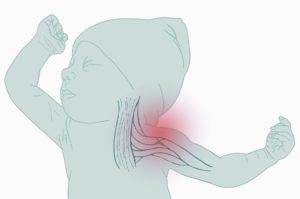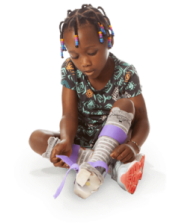What is Erb’s palsy?

Erb’s palsy is a type of brachial plexus injury that affects movement and strength in a baby’s upper arm. The brachial plexus is a network of nerves near the neck that controls the shoulder, arm, and hand.
These nerves can be stretched or torn during a difficult or forceful delivery, leading to weakness or paralysis in the affected arm. In most cases, only one side is involved.
Erb’s palsy is also known as Erb-Duchenne palsy or brachial plexus palsy. It affects up to 2 in 1,000 newborns, according to the American Academy of Orthopedic Surgeons (AAOS).
Many babies with Erb’s palsy improve with early treatment. Physical and occupational therapies can help restore movement, but recovery often demands major changes at home. Parents may need to miss work, adjust routines, or travel to specialists.
Unfortunately, some children never fully recover. Lasting weakness, limited arm function, or visible differences can affect a child’s daily life. In severe cases, surgery may be needed, and even then, full function may not return.
Sometimes, Erb's palsy in newborn babies could have been avoided during delivery. When health care providers use excessive force or miss warning signs, medical negligence may be involved. In these cases, an Erb’s palsy lawsuit can help families afford long-term care.
We partner with birth injury lawyers nationwide who have secured over $1 billion for families, including those impacted by Erb’s palsy.
Find out if we can help your family, too. Get a free case review right now.
Causes of Erb’s palsy
The cause of Erb’s palsy usually involves excessive stretching of the brachial plexus nerves during delivery. While some Erb's palsy risk factors are unavoidable, others involve poor medical decisions or mistakes that lead to preventable nerve injury.
Learn more about common Erb's palsy causes below.
Improper management of shoulder dystocia
Shoulder dystocia occurs when a baby’s shoulder gets stuck behind the mother’s pelvic bone after the head has delivered. When this happens, doctors must act quickly and carefully to avoid injury.
Common errors in managing shoulder dystocia include:
- Failing to perform appropriate maneuvers to release the shoulder
- Neglecting to call for additional help or following emergency protocols
- Not recognizing shoulder dystocia in time to reduce the risk of injury
- Pulling too hard on the baby’s head or neck during delivery
When this medical emergency is not handled correctly, shoulder dystocia is a leading cause of Erb’s palsy.
Misuse of assisted delivery tools
Forceps and vacuum extractors are sometimes used to guide a baby through the birth canal. These tools must be applied with skill and care.
Misuse of assisted delivery tools may involve:
- Applying pressure to the baby’s head in the wrong direction
- Attempting multiple applications after an initial failure
- Choosing to proceed with tools when a C-section would have been safer
- Placing the device incorrectly on the baby’s scalp or head
- Pulling too forcefully or quickly during delivery
Improper use of assisted delivery tools increases the risk of brachial plexus injuries like Erbs palsy.
Excessive pulling during vaginal delivery
Even without shoulder dystocia or tools, a medical provider can cause nerve damage by using too much force during delivery.
Situations that may involve excessive pulling include:
- Attempting to deliver a large baby through a narrow birth canal
- Handling breech deliveries (feet- or buttocks-first) improperly
- Pulling a baby’s head or neck in a way that overstretches the nerves
These actions can result in partial or complete tearing of the brachial plexus in fragile newborns. When excessive force is used unnecessarily, it may be considered medical negligence.
Failure to perform a timely cesarean section
In some cases, a cesarean section (C-section) is the safest way to prevent injury. Delaying surgery when it is medically necessary can lead to complications during vaginal birth.
Common reasons a C-section should be considered include:
- Baby appears too large for safe vaginal delivery (macrosomia)
- Labor is prolonged or not progressing as expected
- Signs of fetal distress or positioning issues are present
Failing to act may increase the risk of nerve damage, like Erbs palsy and other brachial plexus injuries.
Inadequate monitoring of labor progress
Monitoring a mother and baby throughout labor is essential for identifying risks before they lead to harm. When providers fail to recognize or act on warning signs, it can result in serious injury.
Failures that may contribute to Erbs palsy include:
- Failing to adjust the delivery plan when complications arise
- Ignoring signs that labor has stalled or is moving too quickly
- Missing evidence of a high birth weight or abnormal fetal positioning
- Overlooking fetal distress or warning signs during electronic monitoring
Without timely action, these lapses can increase the risk of nerve damage. If you think your baby’s Erbs palsy could have been prevented, you may qualify for compensation to help cover the cost of care.
Find out right now with a free case review.
Signs and symptoms of Erb’s palsy


The symptoms of Erb’s palsy in children can vary depending on the severity of the nerve damage. Some children have mild weakness, while others experience total paralysis in the affected arm.
Signs are often noticeable at birth, but the full extent of harm may not become clear until the baby is 3 to 6 months old.
Common symptoms of Erb’s palsy include:
- Arm hangs by the side with wrist turned inward (“waiter’s tip”)
- Decreased grip strength
- Limited range of motion in the arm or shoulder
- Partial or complete paralysis of the arm
- Weakness in the arm or hand
If your baby shows any of these signs, talk to your doctor as soon as possible. Early diagnosis gives your child the best chance at recovery.
Types of Erb’s palsy
Doctors classify brachial plexus injuries based on how severely the nerves are damaged. These types help determine the treatment and expected recovery for babies with Erb’s palsy.
Learn more about the types of nerve injuries that can cause Erbs palsy below.
Neuropraxia
Neuropraxia is the mildest and most common type of brachial plexus injury. It occurs when the nerve is stretched but not torn. Babies with neuropraxia usually recover fully within weeks to a few months, often without the need for surgery.
Neuroma
A neuroma occurs when a stretched or torn nerve begins to heal, but scar tissue forms at the injury site. This scar tissue can press on healthy nerves and limit recovery. Children with neuromas may regain some function, but often not fully.
Rupture
A rupture is a complete tear of the nerve, but not at the spinal cord. Because these nerves cannot heal on their own, surgical intervention — such as nerve grafting — is usually required to restore function.
Avulsions
Avulsions are the most severe type of nerve injury. They occur when the nerve is torn away from the spinal cord. This can cause permanent paralysis in the arm and may also lead to Horner’s syndrome, affecting the face and eyes.
Erb’s palsy surgery may help improve function by transferring nearby nerves, but the torn nerve cannot be reattached.
If you're unsure what type of nerve injury your baby may have, our registered nurses can help you understand your baby’s condition and what steps to take next.
With decades of combined experience supporting families like yours, our nurses are here to help, and talking with our team is always free.
Erb’s palsy treatment
Some mild cases of Erb’s palsy in newborns improve on their own within a few months. More serious injuries may require ongoing Erb’s palsy treatment, including physical therapy or surgery.
If your child still has limited movement or delayed development after 6 months, more intensive care may be needed to support long-term recovery.
Learn more about Erb’s palsy treatments below.
Physical therapy
Physical therapy is often the first step in treating brachial plexus injuries like Erbs palsy. It helps improve stiffness, immobility, and weakness in the affected shoulder or arm.
Therapists may use gentle massage, range-of-motion exercises, and specialized equipment to support nerve recovery and build strength. Many babies can begin home therapy as early as 3 weeks old, under the guidance of a specialist.
Occupational therapy
Occupational therapy is typically recommended when symptoms don’t improve on their own after 2 to 4 months.
This therapy focuses on helping children build the strength and coordination needed for everyday activities, such as holding a toy or bottle. Occupational therapists use targeted exercises to improve joint function, muscle tone, and fine motor skills.
Surgery
Surgical treatment is sometimes needed for more severe cases of Erbs palsy, especially when there is significant nerve damage or paralysis.
The most common procedure is a nerve transfer, where a healthy nerve from another part of the body is connected to the damaged nerve. In some cases, doctors may also perform a tendon transfer, moving a tendon to improve mobility in the arm, shoulder, or hand.
Early surgical intervention is important, as delays can reduce the chances of full recovery. These procedures can be costly, but money from a lawsuit can help cover the expense.
Get a free case review right now to find out if your family may qualify.
Long-term effects of Erb’s palsy
For some children, Erb’s palsy improves with early therapy and consistent follow-up care. However, when treatment is delayed or the nerve damage is more severe, the effects can be permanent.
If your child’s injury was avoidable, an Erb’s palsy settlement may help your family afford the treatment and support needed for the best possible outcome.
Potential long-term effects of Erb’s palsy include:
- Chronic pain: Ongoing discomfort or sensitivity in the affected arm
- Delayed development: Slower progress with motor skills and milestones
- Joint stiffness: Limited flexibility in the shoulder, elbow, or wrist
- Limited range of motion: Difficulty lifting, rotating, or extending the arm
- Muscle atrophy: Weakening or shrinking of muscles due to lack of use
- Paralysis: Partial or complete loss of movement in the arm or hand
- Poor coordination: Trouble with balance, reaching, or grasping objects
- Self-esteem issues: Emotional effects related to physical limitations
- Uneven arm growth: The affected arm may appear shorter or thinner over time
These outcomes can impact a child’s ability to participate fully in school, play, and daily routines. Early treatment is critical to improve function and reduce long-term harm.
Get legal help for Erb’s palsy
When Erb’s palsy is caused by mistakes during delivery, the effects can be life-altering, not just for your child, but for your entire family.
A preventable nerve injury may require years of therapy, surgery, and support. These costs can be overwhelming, especially when insurance doesn’t cover everything your child needs.
An Erb’s palsy settlement can provide the financial resources to afford high-quality care, adaptive equipment, and long-term stability.
Legal help can also bring answers — and a sense of justice — for families navigating the lifelong impact of avoidable nerve damage.
Cerebral Palsy Guide partners with top birth injury lawyers who can help families in all 50 states. So far, they’ve recovered over $1 billion for families affected by birth injuries, including Erb’s palsy.
Call our team at (855) 220-1101 right now or get a free case review to find out your legal options.





